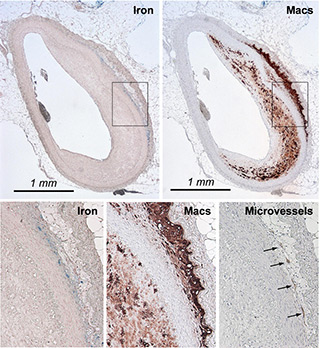Effects of Intraplaque Hemorrhage on Plaque Progression in a Preclinical Model of Atherosclerosis

Histological sections from an atherosclerotic plaque demonstrating the effects of intraplaque hemorrhage. Top row rectangular outlines correspond to bottom row images. Perl’s iron stain shows accumulation of iron (blue) following degradation of red blood cell hemoglobin. Macrophage stain (Macs, brown) shows heavy macrophage presence indicative of inflammation within the same area as the accumulated iron. Endothelial stain (bottom right, brown) shows microvessels in the same region as the iron deposits.
Both inflammation and neovascularization are considered markers of plaque instability.
Although the amount of blood vessel narrowing in the carotid and coronary arteries is a well-established risk factor for strokes and heart attacks, there remain patients with minimal to moderate narrowing who still experience ischemic events. Features and components of the atherosclerotic plaque itself provide additional information about a patient’s risk of having an ischemic event. One such feature is intraplaque hemorrhage (IPH), or bleeding within the plaque. Red blood cells that are deposited in the plaque contribute lipids and hemoglobin-derived iron, both potentially detrimental to the stability of the plaque (Eur Heart J. 2011;32:1977–85 and Arterioscler Thromb Vasc Biol. 2010;30:1347–53).
Even though statins are effective at preventing heart attacks and strokes through the reduction of cholesterol levels, there is no therapy for IPH and its proatherosclerotic effects. We have developed a preclinical model for studying the effects of IPH on atherosclerotic plaques. We have shown that IPH in this model leads to increases in markers of plaque instability. Our aim is to test whether a therapeutic agent targeted toward products of IPH will reduce their harmful effects.


